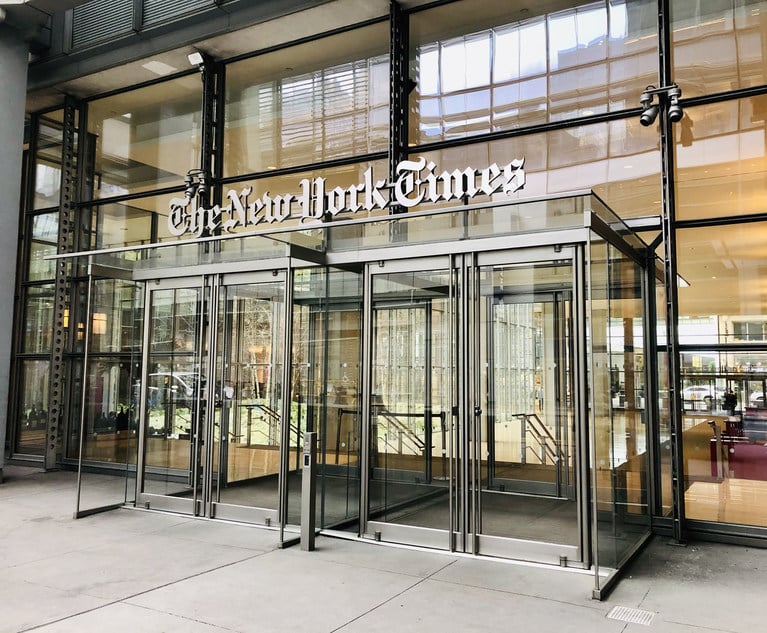Soliciting a Licensee's Customers Doesn't Breach the License, But Could be Tortious
A discussion of the U.S. District Court for the Eastern District of Michigan decision BullsEye Telecom v. BroadSoft, concerning a dispute over whether a licensor of telecommunications software could compete with the licensee's customers for the same services.
August 13, 2018 at 03:06 PM
7 minute read
 Richard Raysman and Peter Brown
Richard Raysman and Peter Brown
On July 31, 2018, the U.S. District Court for the Eastern District of Michigan issued a decision in BullsEye Telecom v. BroadSoft, No. 2:18-cv-10195-VAR-RSW, 2018 WL 3631586 (E.D. Mich. July 31, 2018). The case concerned a dispute over whether a licensor of telecommunications software could compete with the licensee's customers for the same services. Applying New York law as required by the license's forum selection clause, the court first held that the licensee/plaintiff could not allege that defendant/licensor breached the license on these grounds because the license included no provision prohibiting solicitation of licensee's end users. However, the court refused to dismiss plaintiff/licensee's tort claim alleging tortious interference with economic expectancy, as it sufficiently pleaded evidence that defendant/licensor had deployed the licensee's confidential pricing information, deemed a trade secret, to submit the lowest possible bid to the third party and thereby acquire the business.
A further discussion of the facts, procedural history and legal analysis and conclusions is below.
Facts and Procedural History
In 2006, plaintiff BullsEye Telecom, Inc. (BullsEye), a telecommunications provider, licensed digital voice software from defendant BroadSoft, Inc. (BroadSoft). The license did not explicitly bar BroadSoft from selling its software to third parties (the “license”), even via direct sales to existing customers of BullsEye. New York law governed any breach of contract cases arising under the license.
In 2017, BullsEye offered to expand its services to its customer of nine years, Tractor Supply Company (TSC). BullsEye had provided the bulk of TSC's telecommunications services through that time period. BroadSoft also bid on the expansion. BullsEye took issue with BroadSoft's bid. BroadSoft responded that the License did not preclude its bid, irrespective of TSC's status as an existing BullsEye customer.
TSC hired BroadSoft as its new telecommunications service provider, and eventually took the near entirety of its business to BroadSoft. In response, BroadSoft offered a refund to BullsEye to cushion the blow of losing TSC's business.
BroadSoft rejected the offer as a “miniscule” portion of the damages it suffered. Instead, BroadSoft sued for breach of contract, tortious interference with contractual relations and tortious interference with economic expectancy. BroadSoft moved to dismiss for failure to state a claim.
Legal Analysis and Conclusions
The court applied New York law to the breach of contract claim, per the forum selection clause in the license. To support its claim for breach of contract, BullsEye alleged only that “BroadSoft had breached its agreement with BullsEye.” The court rejected this allegation as conclusory. More important, BroadSoft sales to TSC did not violate the license inasmuch as the license did not prohibit sales to end users of BullsEye such as TSC. BullsEye later clarified that BroadSoft's breach of the license constituted a breach of the covenant of good faith because by soliciting TSC, BroadSoft “prevented [BullsEye] from receiving the benefits” of the license.
Again the court rejected its argument. The covenant of good faith does not create new substantive rights, nor does it “require a party to forego its own interests, even if such acts 'incidentally lessen' the opposing party's commercial rights” and “impose any obligations 'inconsistent with other terms' of the contract,” but does encompass a promise that a reasonable person in a position of the promisee would understand as warranted if included in the agreement.” (emphasis added). The court analogized the situation in the instant case to a 2014 case in state Supreme Court for New York County in which plaintiff stated a plausible breach of the covenant of good faith claim when defendant, while not in contravention of the underlying contract directly in its express terms, by opening a competing store in the relevant territory without disclosing these plans to plaintiff, could have “spoil[ed] the purpose of the contract with plaintiff.” See JJM Sunrise Automotive, LLC v. Volkswagen Grp. of Am., Inc., 997 N.Y.S.2d 270 (N.Y. Sup. Ct. N.Y. Cty. 2014). Notwithstanding the similarities, the court granted BroadSoft's motion to dismiss without prejudice on grounds that the allegations in BullsEye's complaint could not “merely allege a conclusion in the complaint and then provide facts in a brief.”
Applying Michigan law to the tort claims, the court likewise dismissed BullsEye's claim for tortious interference with contractual relationships. What doomed BullsEye was its lack of a contract with TSC at the time the latter had been solicited by BroadSoft. Accordingly, BullsEye could not plead the second element of the claim: a breach by a third party—i.e., BroadSoft.
BullsEye's claim for tortious interference with economic expectancy did survive the motion to dismiss. BullsEye argued that BroadSoft intentionally and knowingly deprived it of economic expectancy by interfering in the nearly decade-long business relationship with TSC. The elements for a tortious interference with economic expectancy claim are: (1) existence of a valid business relationship; (2) defendant's knowledge of the relationship; (3) intentional interference that causes or induces termination of the relationship or expectancy; and (4) resulting damages.
BullsEye satisfied the first element because, given its lengthy contractual relationship with TSC and its history of acquiring such a relationship based on competitive bids, unlike a “pitch meeting” between a supplier and a customer, future negotiations between BullsEye and TSC were likely to be more fruitful. Accordingly, BullsEye demonstrated a “probable or reasonable expectancy of winning the digital voice bid absent BroadSoft's interference.” Reading the pleadings favorably and accepting them as true, BullsEye sufficiently pled the second element in part because BroadSoft had used confidential price information to undercut BullsEye's bid to TSC, which evidenced knowledge of BullsEye's relationship with TSC.
The additional aspect of the second element—requiring BullsEye to show that BroadSoft intentionally interfered with the BullsEye's relationship with TSC, required a showing of acts committed that were “per se wrongful” or a “lawful act with malice” that is “unjustified in law.” BullsEye argued that BroadSoft's use of confidential information in obtaining TSC's business was per se wrongful as trade secret misappropriation. BroadSoft countered only with disputes over the factual basis for the allegations and offered “no legal argument.” This was insufficient on a motion to dismiss, as it is black letter law that a motion to dismiss is an improper stage in which to resolve factual disputes. Accordingly, when accepting each of BullsEye's facts as true in the complaint and drawing every reasonable inference in its favor, the court held that BullsEye's claim that BroadSoft utilized confidential information to undercut its pricing vis-a-vis the TSC account sufficiently provided factual support for its allegation that BroadSoft committed an act that was “per se” wrongful in satisfaction of the intent aspect of this element.
In sum, the court dismissed BullsEye's claims for breach of contract and tortious interference with contractual relations, but denied the motion to dismiss for tortious interference with economic expectancy.
Richard Raysman is a partner at Holland & Knight. Peter Brown is the principal at Peter Brown & Associates. They are co-authors of “Computer Law: Drafting and Negotiating Forms and Agreements” (Law Journal Press).
This content has been archived. It is available through our partners, LexisNexis® and Bloomberg Law.
To view this content, please continue to their sites.
Not a Lexis Subscriber?
Subscribe Now
Not a Bloomberg Law Subscriber?
Subscribe Now
NOT FOR REPRINT
© 2025 ALM Global, LLC, All Rights Reserved. Request academic re-use from www.copyright.com. All other uses, submit a request to [email protected]. For more information visit Asset & Logo Licensing.
You Might Like
View All
‘Issue of First Impression’: New York Judge Clears Coinbase Appeal Amid Crypto Regulatory Clash
4 minute read
New York Times Moves for $100K in Attorney Fees Against Dfinity Foundation
3 minute read
Health Care Data Breach Class Actions Saw December Surge in NY Courts

Trending Stories
- 1SDNY US Attorney Damian Williams Lands at Paul Weiss
- 2Litigators of the Week: A Knockout Blow to Latest FCC Net Neutrality Rules After ‘Loper Bright’
- 3Litigator of the Week Runners-Up and Shout-Outs
- 4Norton Rose Sues South Africa Government Over Ethnicity Score System
- 5KMPG Wants to Provide Legal Services in the US. Now All Eyes Are on Their Big Four Peers
Who Got The Work
Michael G. Bongiorno, Andrew Scott Dulberg and Elizabeth E. Driscoll from Wilmer Cutler Pickering Hale and Dorr have stepped in to represent Symbotic Inc., an A.I.-enabled technology platform that focuses on increasing supply chain efficiency, and other defendants in a pending shareholder derivative lawsuit. The case, filed Oct. 2 in Massachusetts District Court by the Brown Law Firm on behalf of Stephen Austen, accuses certain officers and directors of misleading investors in regard to Symbotic's potential for margin growth by failing to disclose that the company was not equipped to timely deploy its systems or manage expenses through project delays. The case, assigned to U.S. District Judge Nathaniel M. Gorton, is 1:24-cv-12522, Austen v. Cohen et al.
Who Got The Work
Edmund Polubinski and Marie Killmond of Davis Polk & Wardwell have entered appearances for data platform software development company MongoDB and other defendants in a pending shareholder derivative lawsuit. The action, filed Oct. 7 in New York Southern District Court by the Brown Law Firm, accuses the company's directors and/or officers of falsely expressing confidence in the company’s restructuring of its sales incentive plan and downplaying the severity of decreases in its upfront commitments. The case is 1:24-cv-07594, Roy v. Ittycheria et al.
Who Got The Work
Amy O. Bruchs and Kurt F. Ellison of Michael Best & Friedrich have entered appearances for Epic Systems Corp. in a pending employment discrimination lawsuit. The suit was filed Sept. 7 in Wisconsin Western District Court by Levine Eisberner LLC and Siri & Glimstad on behalf of a project manager who claims that he was wrongfully terminated after applying for a religious exemption to the defendant's COVID-19 vaccine mandate. The case, assigned to U.S. Magistrate Judge Anita Marie Boor, is 3:24-cv-00630, Secker, Nathan v. Epic Systems Corporation.
Who Got The Work
David X. Sullivan, Thomas J. Finn and Gregory A. Hall from McCarter & English have entered appearances for Sunrun Installation Services in a pending civil rights lawsuit. The complaint was filed Sept. 4 in Connecticut District Court by attorney Robert M. Berke on behalf of former employee George Edward Steins, who was arrested and charged with employing an unregistered home improvement salesperson. The complaint alleges that had Sunrun informed the Connecticut Department of Consumer Protection that the plaintiff's employment had ended in 2017 and that he no longer held Sunrun's home improvement contractor license, he would not have been hit with charges, which were dismissed in May 2024. The case, assigned to U.S. District Judge Jeffrey A. Meyer, is 3:24-cv-01423, Steins v. Sunrun, Inc. et al.
Who Got The Work
Greenberg Traurig shareholder Joshua L. Raskin has entered an appearance for boohoo.com UK Ltd. in a pending patent infringement lawsuit. The suit, filed Sept. 3 in Texas Eastern District Court by Rozier Hardt McDonough on behalf of Alto Dynamics, asserts five patents related to an online shopping platform. The case, assigned to U.S. District Judge Rodney Gilstrap, is 2:24-cv-00719, Alto Dynamics, LLC v. boohoo.com UK Limited.
Featured Firms
Law Offices of Gary Martin Hays & Associates, P.C.
(470) 294-1674
Law Offices of Mark E. Salomone
(857) 444-6468
Smith & Hassler
(713) 739-1250






